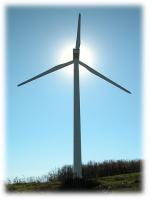 You may or may not know, but most food production uses a lot of oil. A lot of this oil is used in the production of fertilizer. As mentioned in the previous post, the University of Minnesota is working on a way to use windpower air and water to create nitrogen fertilizer. This would significantly reduce the amount of oil that is used on our nations fields. Providing a sustainable way to create fertilizer (if using fertilizer is a good idea or not I leave to another debate).
You may or may not know, but most food production uses a lot of oil. A lot of this oil is used in the production of fertilizer. As mentioned in the previous post, the University of Minnesota is working on a way to use windpower air and water to create nitrogen fertilizer. This would significantly reduce the amount of oil that is used on our nations fields. Providing a sustainable way to create fertilizer (if using fertilizer is a good idea or not I leave to another debate).
from here
A project to convert wind energy into hydrogen that can be used for anhydrous ammonia fertilizer is underway at the University of Minnesota West Central Research and Outreach Center (WCROC). The project aims to provide a renewable alternative that can be locally produced to part of $300 million of anhydrous ammonia derived from fossil fuels currently used as nitrogen fertilizer in Minnesota agriculture.
“We are pleased to lead the development of this globally unique pilot project and believe that the technology developed will make a positive and substantial impact on the state’s economy and environment, †Greg Cuomo, WCROC Department Head.
The pilot project to use wind, water and air to produce nitrogen fertilizer and Minnesota’s wind energy, hydrogen and agriculture industries received a huge boost when the Minnesota Legislature and Governor, as part of the 2006 Bonding Bill, provided $2.5 million to construct this globally unique Wind-to-Hydrogen-to-Ammonia Pilot Project at the WCROC. Representative Torrey Westrom (R, Elbow Lake) and Senator Dallas Sams (D, Staples) carried the initial legislation. The project will leverage previous resources provided by the University of Minnesota Initiative for Renewable Energy and the Environment and the Legislative Commission on Minnesota Resources.
great idea, but how much is fertilizer like this going to cost?
Well you don’t have to pay for the oil to make the fertilizer, so the potential is there for it to cost even less than “normal” fertilizer.